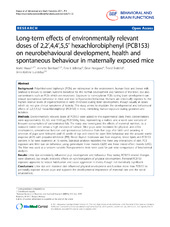| dc.contributor.author | Haave, Marte | eng |
| dc.contributor.author | Bernhard, Annette | eng |
| dc.contributor.author | Jellestad, Finn K. | eng |
| dc.contributor.author | Heegaard, Einar | eng |
| dc.contributor.author | Brattelid, Trond | eng |
| dc.contributor.author | Lundebye, Anne-Katrine | eng |
| dc.date.accessioned | 2012-02-07T11:26:36Z | |
| dc.date.available | 2012-02-07T11:26:36Z | |
| dc.date.issued | 2011-01-13 | eng |
| dc.Published | Behavioral and Brain Functions 2011, 7:3 | en |
| dc.identifier.issn | 1744-9081 | en_US |
| dc.identifier.uri | http://hdl.handle.net/1956/5566 | |
| dc.description.abstract | Background: Polychlorinated biphenyls (PCBs) are widespread in the environment, human food and breast milk. Seafood is known to contain nutrients beneficial for the normal development and function of the brain, but also contaminants such as PCBs which are neurotoxic. Exposure to non-coplanar PCBs during brain development can disrupt spontaneous behaviour in mice and lead to hyperactive behaviour. Humans are chronically exposed to the highest relative levels of organochlorines in early childhood during brain development, though usually at doses which do not give clinical symptoms of toxicity. This study aimed to elucidate the developmental and behavioural effects of 2,2’,4,4’,5,5’ hexachlorobiphenyl (PCB153) in mice, mimicking human exposure during gestation and lactation. Methods: Environmentally relevant doses of PCB153 were added to the experimental diets. Feed concentrations were approximately 0.5, 6.5, and 1500 μg PCB153/kg feed, representing a realistic and a worst case scenario of frequent consumption of contaminated fish. The study also investigated the effects of maternal nutrition, i.e. a standard rodent diet versus a high inclusion of salmon. Mice pups were examined for physical- and reflex development, sensorimotor function and spontaneous behaviour from five days after birth until weaning. A selection of pups were followed until 16 weeks of age and tested for open field behaviour and the acoustic startle response (ASR) with prepulse inhibition (PPI). Blood thyroid hormones and liver enzymes, blood lipids and PCB153 content in fat were examined at 16 weeks. Statistical analyses modelled the three way interactions of diet, PCB exposure and litter size on behaviour, using generalized linear models (GLM) and linear mixed effect models (LME). The litter was used as a random variable. Non-parametric tests were used for pair wise comparisons of biochemical analyses. Results: Litter size consistently influenced pup development and behaviour. Few lasting PCB153 related changes were observed, but results indicated effects on synchronization of physical development. Perinatal PCB153 exposure appeared to reduce habituation and cause aggression in males, though not statistically significant. Conclusions: Litter size and maternal diet influenced physical development and function more than PCB153 in perinatally exposed mouse pups and supports the developmental importance of maternal care and the social environment. | en_US |
| dc.language.iso | eng | eng |
| dc.publisher | BioMed Central | en_US |
| dc.rights | Attribution CC BY | eng |
| dc.rights.uri | http://creativecommons.org/licenses/by/2.0/ | eng |
| dc.title | Long-term effects of environmentally relevant doses of 2,2’,4,4’,5,5’ hexachlorobiphenyl (PCB153) on neurobehavioural development, health and spontaneous behaviour in maternally exposed mice | en_US |
| dc.type | Peer reviewed | |
| dc.type | Journal article | |
| dc.description.version | publishedVersion | en_US |
| dc.rights.holder | Copyright 2011 Haave et al; licensee BioMed Central Ltd. | en_US |
| dc.identifier.doi | https://doi.org/10.1186/1744-9081-7-3 | |
| dc.identifier.cristin | 830614 | |
| dc.subject.nsi | VDP::Medical disciplines: 700::Clinical medical disciplines: 750::Neurology: 752 | en_US |

